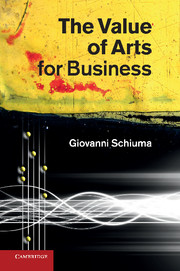Book contents
- Frontmatter
- Contents
- List of figures
- List of boxes
- Acknowledgements
- Foreword
- Introduction
- 1 Why arts matter in management
- 2 The arts into action: Arts-based Initiatives
- 3 The value of Arts-based Initiatives in business
- 4 Arts-based Initiatives and business performance
- 5 Managing Arts-based Initiatives to improve business performance
- A closing remark
- Appendix
- Notes
- References
- Index
2 - The arts into action: Arts-based Initiatives
Published online by Cambridge University Press: 05 July 2011
- Frontmatter
- Contents
- List of figures
- List of boxes
- Acknowledgements
- Foreword
- Introduction
- 1 Why arts matter in management
- 2 The arts into action: Arts-based Initiatives
- 3 The value of Arts-based Initiatives in business
- 4 Arts-based Initiatives and business performance
- 5 Managing Arts-based Initiatives to improve business performance
- A closing remark
- Appendix
- Notes
- References
- Index
Summary
Introduction
All organisations have the arts within their business or at least the aesthetic manifestations of art forms. The brand or the identity of a company, for example, is ultimately represented by a logo or images that are built on art symbols that present and communicate the organisation through aesthetic expressions. The use of art forms is also spread throughout an organisation. Office spaces are defined, shaped and decorated by arts-based manifestations. An explicit example of this can be found in the lobbies, recreation and meeting areas of office buildings. They look more and more like art galleries, aimed at welcoming company stakeholders by generating aesthetic experiences that affect people's perceptions and touch their feelings. But more generally, art forms can inhabit many corners of the workplace. Paintings, photographs or simply posters can be hung on the walls. Sculptures or art installations can shape and decorate internal and external office spaces. Music can be broadcasted into offices. The arts pervade organisations. However, not all organisations use artistic products and processes to address management challenges and solve business problems. Most organisations simply use the arts more or less implicitly because they are an integral part of human life and people tend to surround themselves with art forms.
- Type
- Chapter
- Information
- The Value of Arts for Business , pp. 45 - 87Publisher: Cambridge University PressPrint publication year: 2011



